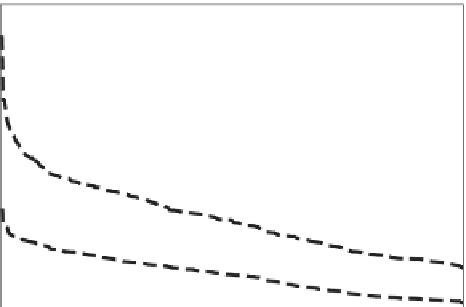Geography Reference
In-Depth Information
1000
a)
b)
100
10
simulated
1
observed
0.1
0.01
0.001
0.01
1
10
30
50
70
90
99
99.99
0.01
1
10
30
50
70
90
99
99.99
Percent of time exceeded
Percent of time exceeded
Figure 7.16. Simulated monthly FDCs in (a) a dry region (Tati catchment, Botswana, 570 km
2
) and (b) a somewhat wetter region (Mwarazi
catchment, Zimbabwe, 202 km
2
).
100
a)
b)
80
60
simulated
40
observed
20
0
0
20
40
60
80
100
0
20
40
60
80
100
Percent of time exceeded
Percent of time exceeded
Figure 7.17. Uncertainty simulation results for two of the gauged upper catchments in the Congo River basin: (a) sub-basin 82, (b) sub-basin 85.
Dashed lines show 90% uncertainty bounds. From Tshimanga et al.(
2011
).
variations in parameter values were generally a reflection
of what might be expected given the conceptual interpret-
ation of the model structure and the limited knowledge
available about the physical catchment characteristics of
the sites used. These observations, plus additional experi-
ence over many years of applying the Pitman model,
contributed to the development and application of param-
eter estimation approaches for the Pitman model, as
reported in Kapangaziwiri and Hughes (
2008
). The
approach adopted for parameter selection in Kapangaziwiri
and Hughes (
2008
) is based on a-priori estimation of
most of the parameters of the Pitman model using esti-
mates of physical basin properties. The results for
selected basins show that the revised parameters are at
least as good as regionalised sets (using techniques dis-
cussed in
Chapter 10
) or give satisfactory results in areas
where no regionalised parameters exist. However, in order
to make the approach applicable to ungauged catchments,
the remaining parameters, mostly associated with intercep-
tion and evaporation processes, should also be estimated
a priori (without calibration).
Hughes and Mantel (
2010
) used the Pitman model for
Monte Carlo sampling from parameter probability distri-
butions to generate ensemble outputs of time series and
therefore also estimates of uncertainty of FDCs. This
may be useful for ungauged basins where it is difficult
to evaluate the applicability of a single regionalised
parameter set. An example of this application is pre-
sented in
Chapter 11
(Case studies). Some of these
principles have been applied to setting up the model
for the large Congo River basin (Tshimanga et al.,
2011
).
Figure 7.17
shows two examples of initial uncer-
tainty estimates based on FDCs for the upper parts of the
Congo River basin. The uncertainty is quite large, and in































































































Search WWH ::

Custom Search